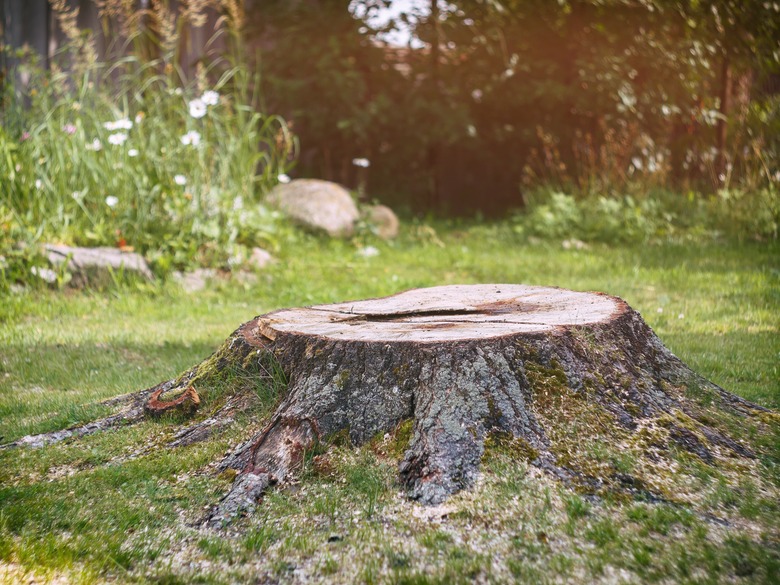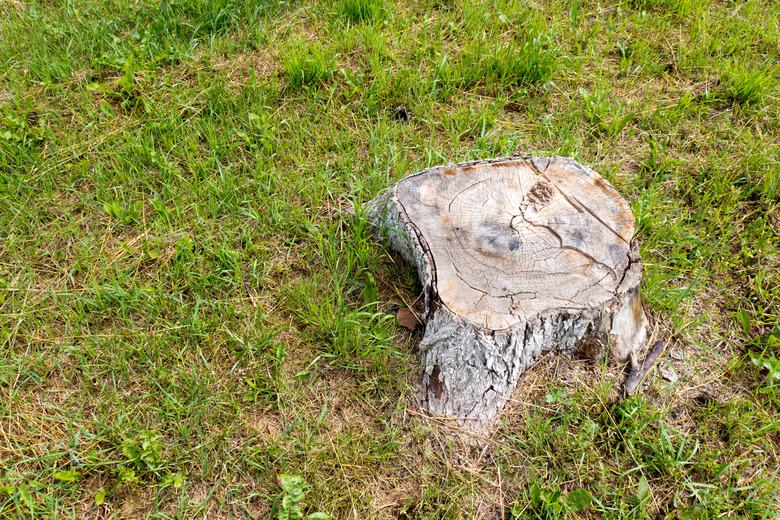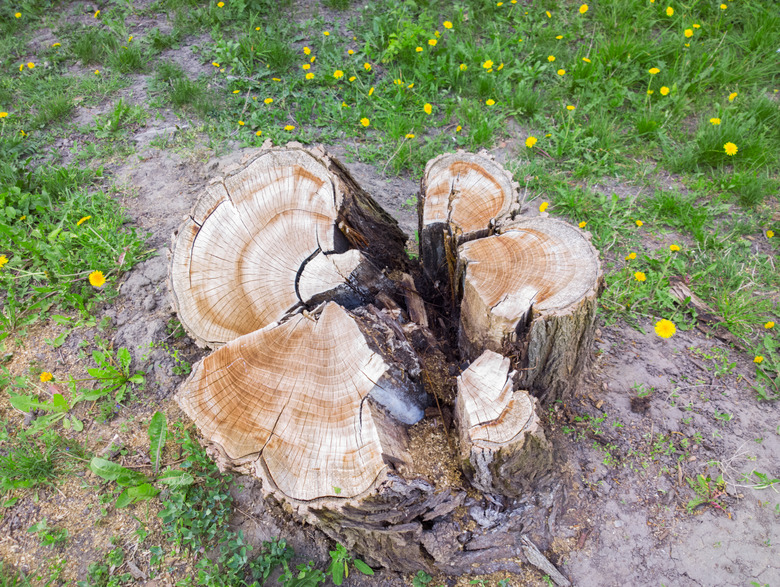How To Remove A Tree Stump: A DIY Guide
We may receive a commission on purchases made from links.
After a tree is lost in a storm or after you have it removed by a tree removal service, you are left with the task of how to remove the tree stump. In many ways, stump removal is harder than removing the tree itself. To choose from the several methods available, you'll need to weigh which is more important to you: speed, economy or ease of effort. Inexpensive, easy methods tend to be slow, while fast methods usually involve somewhat-pricey tool rental or intense physical labor. But, while this task may be painstaking, it does not necessarily have to be handled by a professional, provided you have the patience and the equipment for a proper DIY.
How to Dig Out a Tree Stump by Hand
How to Dig Out a Tree Stump by Hand
Stump removal can be achieved by good old-fashioned hard labor using shovels and saws. This method is most practical for relatively small trees; it can be a multiday project if your goal is to remove a large, massive stump. This method has the advantage of being the least expensive option, but be prepared to spend quite a lot of time as well as effort to get the job done. A helper or two is useful, and caution is required since you will be using cutting tools. Make sure to wear safety glasses and hearing protectors when using cutting tools.
- Dig down around the base of the tree stump using a garden shovel. As you dig, remove the exposed roots as you encounter them, creating access to the deeper root system. Be prepared to spend some time on this; large tree stumps may require a couple of afternoons of digging and cutting. Pile up the soil as you remove it; this will make it easier to backfill the hole during the final stages.
- As small- and medium-size roots are exposed, cut them away from the stump with loppers or a bow saw. Cut as close to the tree stump as you can and remove as much of the roots as you can to open up the digging hole.
- Cut out larger roots using a reciprocating saw fitted with a pruning blade. If you are using a corded saw, make sure it is plugged into a GFCI outlet or GFCI-protected extension cord. There is always danger of shock when using a power tool at ground level.
- The sharpened end of a tamping/digging bar or an adze can also be used to hack out roots near the base of the stump or beneath it. Some trees or large shrubs have tap roots that you can only reach from beneath the stump.
- When all exposed roots are severed, attempt to pry out the stump from one side. As you bend the stump over, cut away any additional roots that become exposed.
- If necessary with very large stumps, you can use a come-along hand winch attached to an anchor point to pull the stump out of the hole. In extreme cases, a logging chain attached to a car's trailer hitch can be used to pull a large stump free of the hole.
- Once the stump has been pulled out of the hole, backfill the hole with soil and then sow grass seed, lay sod or install other landscape plants as you wish.
How to Remove a Tree Stump by Grinding
How to Remove a Tree Stump by Grinding
The fastest, most surefire way to remove a tree stump is by grinding it out with a gas-powered stump grinder. You can rent a compact stump grinder at home improvement centers and tool lease outlets. Rental costs are about $80 to $100 for a day. Another option is to hire a company specializing in this work that can do the job in less than one hour. However, professional service comes at a fairly steep price and is likely to cost more than renting a stump grinder.
Make sure to wear safety glasses, hearing protectors and protective clothing when using a stump grinder. The equipment is loud, and the blades will throw wood chips as they grind down the stump. Be aware that although grinding can remove a good deal of the stump, some amount of underground wood will remain. Over time, this will rot away and settle, leaving you a depression that will need to be filled with additional soil. Such settling may continue for several years.
- Remove any rocks or obstacles around the tree stump. It's important not to hit rocks or metal with the grinder, as you will be held financially responsible for any damage to the blades.
- Fill up the grinder's gas tank and oil reservoir as directed by the instruction manual.
- Position the grinding machine so the cutting head is directly over the stump. Lock the wheels to prevent the grinder from moving once you start the engine to begin work.
- Review the instruction manual to make sure you understand the operating procedure.
- Start the engine of the stump grinder and grind down the stump by pivoting the cutting head back and forth over it while applying modest downward pressure.
- Continue to grind until you've lowered the stump to at least 6 to 8 inches below the surface of the ground. The more wood you can remove, the less subsequent settling will occur.
- When the stump has been lowered to your satisfaction, shut off the grinder, move it off to the side and remove the wood chips with a rake.
- Backfill the hole with soil and cover the area with grass seed, sod or landscape plants as you desire.
How to Rot Out a Tree Stump
How to Rot Out a Tree Stump
Like any organic material, a dead stump from a tree or large shrub will eventually rot away when it's in constant contact with damp soil. This can take many years unless you find a way to encourage the natural process. Using a chemical stump remover is one way to do this. These compounds consist mostly of powdered potassium nitrate and similar chemicals, formulated to speed up the decomposition process by fostering growth of parasitic organisms.
While this method is quite easy, it has the drawback of taking quite a bit of time. While manual removal can get rid of a stump in a long afternoon of work, this chemical removal method can take several months until the stump becomes soft enough to be broken up and removed. To be most effective, there is still some physical work with cutting tools required.
- Use a chainsaw or reciprocating saw to cut the stump as close to ground level as you can. The goal is to shrink the volume of the stump as much as possible, reducing the amount of wood that needs to be rotted away.
- Use a 1-inch spade bit to drill a series of 12-inch-deep holes about 3 to 4 inches back from the edge of the stump, spaced every 6 to 8 inches.
- Then, drill angled holes through the face of the stump coming in from the sides to intersect with the vertical holes. Make sure the side holes are angled slightly downward and that they meet the vertical holes well above the bottom of the hole. These side holes will allow air into the stump to aid decomposition.
- Pour 3 to 4 ounces of chemical stump remover into each hole. Fill the holes with water to help the chemicals soak in.
- Leave the stump alone for four to six weeks as the chemicals do their work. It's best to cover the stump with a tarp or piece of scrap plywood so animals and children cannot come into contact with the chemicals. The stump will gradually begin to soften and decay.
- When the stump has visibly softened, use a sharp axe to break it apart into pieces that can be removed. If necessary, you can repeat the drilling and application of chemicals as harder wood is exposed when the upper portions are broken away.
- Once you have removed the stump to well below ground level, you can backfill the area with soil and replant with sod, grass seed or landscape plants.
How to Remove a Tree Stump With a Garden
How to Remove a Tree Stump With a Garden
If you are very patient and enjoy gardening anyway, you can build a raised gardening bed with timbers or retaining wall blocks up around the stump, fill it with soil, plant your favorite specimens in the raised bed and enjoy your garden for several years. Over time, the buried stump will gradually decay and dissolve away. Should you then want to return the space to lawn, you can remove the walls and soil and then add grass seed or sod to blend in the area where the stump was located.
This method is most successful if you first cut off the stump as close to ground level as possible using a chainsaw or reciprocating saw. Drilling deep holes down into the stump will encourage dirt and moisture to enter the wood when you bury the stump, fostering the microorganisms that will cause the desired decay.
In a variation of this method, a raised berm can be created by heaping soil over the stump area. The berm can then be planted to serve as an ornamental shrub island in your yard.


